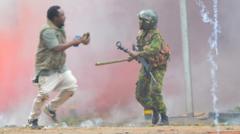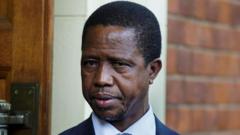After withdrawing hundreds of troops, the U.S. navigates a complex security environment in post-civil war Syria, with a focus on the resurgence of the Islamic State.
US Troop Withdrawal from Syria Signals a Shifting Political Landscape

US Troop Withdrawal from Syria Signals a Shifting Political Landscape
Recent military actions reflect changes following the Assad regime's collapse.
In a significant development, the United States has embarked on reducing its troop presence in northeastern Syria, paralleling the recent political changes stemming from the downfall of long-standing President Bashar al-Assad. As a result, the U.S. military has begun closing three out of its eight operational bases in the region, shrinking troop numbers from around 2,000 to approximately 1,400.
Senior officials, speaking on the condition of anonymity, indicated that the ongoing assessment will determine the fate of remaining forces in Syria after a 60-day evaluation period. While U.S. commanders recommend maintaining a contingent of at least 500 troops to combat the ongoing threats posed primarily by the Islamic State, concerns loom about President Trump's skepticism towards sustaining a military footprint in the region.
The recent troop drawdown highlights the evolving risks associated with the fluid security landscape post-Assad era. Although major threats from Iranian-backed militias and Russian forces have diminished with the regime's exit, the Islamic State's resurgence remains a critical concern, particularly in northeastern Syria where U.S. forces are chiefly stationed.
A pivotal moment occurred last month when the Kurdish-led forces governing northeastern Syria opted to merge with the newly established government in Damascus. This decision marks an important step towards potential unity in a nation still grappling with violence and unrest, reflecting the complexities that come with rebuilding Syria in the wake of civil war. As the United States continues to reassess its military commitments, the outcomes will be pivotal for shaping the country’s future and stability.
Senior officials, speaking on the condition of anonymity, indicated that the ongoing assessment will determine the fate of remaining forces in Syria after a 60-day evaluation period. While U.S. commanders recommend maintaining a contingent of at least 500 troops to combat the ongoing threats posed primarily by the Islamic State, concerns loom about President Trump's skepticism towards sustaining a military footprint in the region.
The recent troop drawdown highlights the evolving risks associated with the fluid security landscape post-Assad era. Although major threats from Iranian-backed militias and Russian forces have diminished with the regime's exit, the Islamic State's resurgence remains a critical concern, particularly in northeastern Syria where U.S. forces are chiefly stationed.
A pivotal moment occurred last month when the Kurdish-led forces governing northeastern Syria opted to merge with the newly established government in Damascus. This decision marks an important step towards potential unity in a nation still grappling with violence and unrest, reflecting the complexities that come with rebuilding Syria in the wake of civil war. As the United States continues to reassess its military commitments, the outcomes will be pivotal for shaping the country’s future and stability.




















